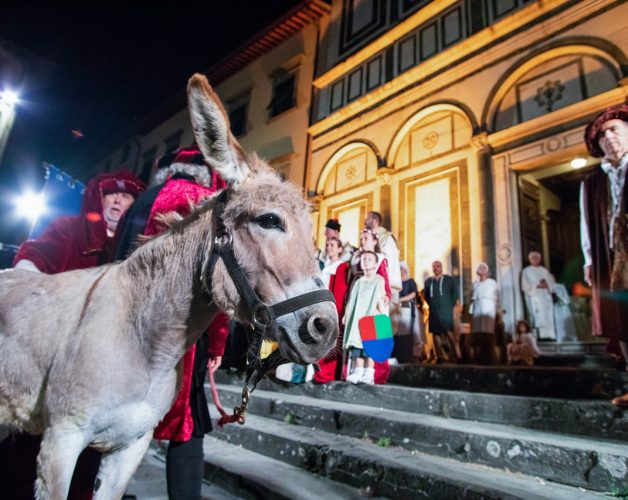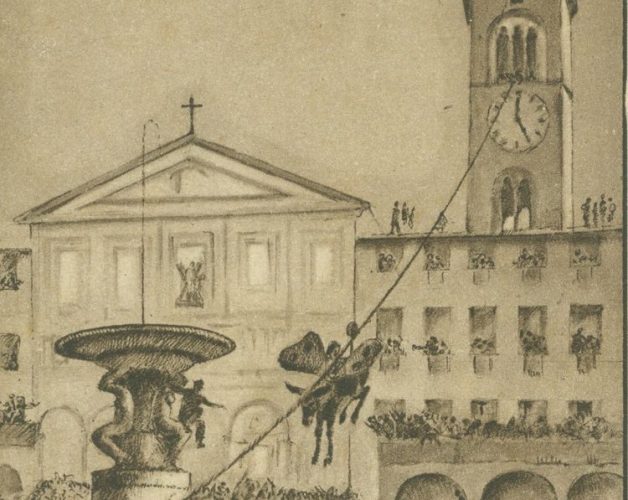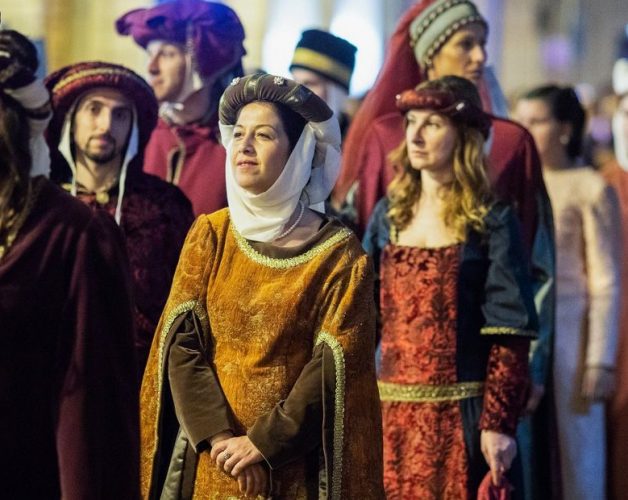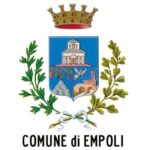In Empoli, in the past, the most important religious holidays were marked by the liturgical calendar. There is the feast of the patron saint, Sant’Andrea or Saint Andrew, on 30 November and, beginning in 1264, that of Corpus Christi, a date which moves depending on Easter, but which always falls in May or June. These two feast days are still celebrated by the city: on the occasion of the patron saint’s feast, the Sant’Andrea d ‘Oro is awarded every year to citizens who have made an outstanding contribution to the fields of culture, arts, labour, politics, sports or solidarity. For Corpus Domini, there is the historic fair, which today takes the form of an amusement park, and in recent years the traditional Volo del Ciuco [Flight of the Donkey], which has been revived once again. For five centuries, from 1397 to its abolition in 1861, it had entertained the people of Empoli.
It was exactly on the day of Corpus Christi in 1340 that the Compagnia di Sant’Andrea [Fellowship of Saint Andrew] was established, the oldest Empolese lay confraternity. To celebrate this event, the founders decided to organise a series of entertainments every year in addition to the liturgical celebrations.
The most outstanding of these is the Flight of the Donkey, perhaps the festival with the deepest roots in Empoli’s historical memory. On the day of Corpus Christi, a poor donkey (called a Ciuco in Tuscan dialect) was carried up the bell tower of the Collegiate Church, suspended from a pulley on a rope, and “flown” over the heads of the citizens gathered in Piazza Farinata degli Uberti, until it crashed into one of the columns of the loggia of Palazzo Ghibellino. Depending on how the flight went, predictions and forecasts were made regarding the fate of the field crops.


According to tradition, which has no historical basis, the flight of the donkey in Empoli began in 1397 as a slap in the face against the forces of San Miniato, after their failed rebellion against the Florentines; the people of Empoli, and particularly the commander Cantino Cantini, had made a considerable contribution to this failed enterprise. The legend is based on a humorous-heroic poem by Ippolito Neri (1652-1709), entitled La presa di Saminiato [The Taking of Saminiato], inspired by the events of 1397. To spark the reader’s hilarity, Neri added a number of fictitious anecdotes to the historical facts, such as the episode of the herd of goats with little lights hanging from their horns, positioned by night in the plain in front of the fortress of San Miniato to create the impression of a large army waiting to ambush and force the people of San Miniato to surrender. The legend of the flight instead comes from the words of Silvera, the leader of the San Miniato army, before his city fell into the hands of the Empolese, that donkeys would be seen flying through the sky.
After five centuries, in 1861, with the proclamation of the Kingdom of Italy, the Flight of the Donkey was abolished, not only because of its cruelty, but also because it was an expression of an era of obscurantism and provincialism that should definitively be left behind.
Today the festival has been revived thanks to the Compagnia di Sant’Andrea. Every year, it organises not only the spectacular Flight (which today is evoked by making a fake donkey fly), but also the historical parade and Palio del Ciuco , which sees the participation of the three castles that formerly formed the League of Empoli, namely Empoli, Pontorme and Monterappoli.

